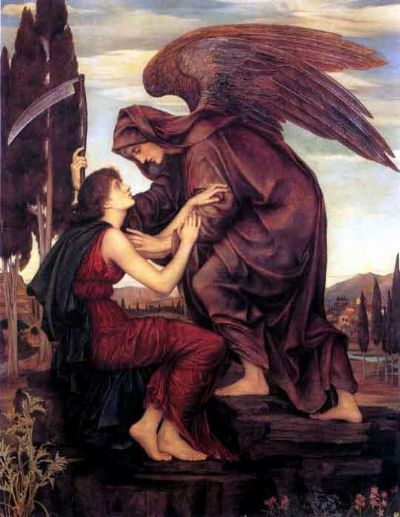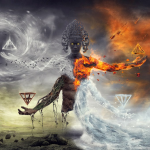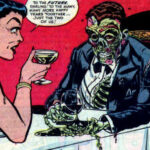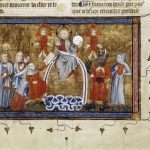In the Bible, death is viewed under form of an angel sent from God, a being deprived of all voluntary power. On some occasions this described in terms fitting Azrael, and on others as fitting Samael.

The biblical Book of Job (xxxiii. 22) uses the general term “destroyer” (“memitim”), which tradition has identified with “destroying angels” (“mal’ake Kabbalah”) and Prov. xvi. 14 uses the term the “angels of death” (“mal’ake ha-mawet”).
Origin
The angel of death was created by God on the first day (Tan. on Gen. xxxix. 1). His dwelling is in heaven, whence he reaches earth in eight flights, whereas pestilence reaches it in one (Ber. 4b). He has twelve wings (Pirḳe R. El. xiii). “Over all people have I surrendered thee the power,” said God to the angel of death, “only not over this one which has received freedom from death through the Law” (Tan. to Ex. xxxi. 18; ed. Stettin, p. 315).
The “angel of the Lord” smites 185,000 men in the Assyrian camp (II Kings xix. 35). “The destroyer” kills the first-born of the Egyptians (Ex. xii. 23), and the “destroying angel” (“mal’ak ha-mashḥit”) rages among the people in Jerusalem (II Sam. xxiv. 15). In I Chronicle xxi. 15 the “angel of the Lord” is seen by King David standing “between the earth and the heaven, having a drawn sword in his hand stretched out over Jerusalem.”
Description
It is said of the angel of death that he is full of eyes. In the hour of death he stands at the head of the departing one with a drawn sword, to which clings a drop of gall. As soon as the dying man sees the angel, he is seized with a convulsion and opens his mouth, whereupon the angel throws the drop into it. This drop causes his death; he turns putrid, and his face becomes yellow (‘Ab. Zarah 20b; in detail, Jellinck, “B. H.” i. 150; for the eyes compare Ezek. i. 18 and Rev. iv. 6). The expression “to taste of death” originated in the idea that death was caused by a drop of gall (“Jew. Quart. Rev.” vi. 327).
The soul escapes through the mouth, or, as is stated in another place, through the throat; therefore the angel of death stands at the head of the patient (Jellinek, l.c. ii. 94, Midr.Teh. to Ps. xi.). When the soul forsakes the body its voice goes from one end of the world to the other, but is not heard (Gen. R. vi. 7; Ex. R. v. 9).
The drawn sword of the angel of death, mentioned by the Chronicler (I. Chron. xxi. 15; comp. Job xv. 22; Enoch lxii. 11), indicates that the angel of death was figured as a warrior who kills off the children of men. “Man, on the day of his death, falls down before the angel of death like a beast before the slaughterer”
In later representations the knife sometimes replaces the sword, and reference is also made to the cord of the angel of death, which indicates death by throttling. Moses says to God: “I fear the cord of the angel of death” (Grünhut, l.c. v. 103a et seq.). Of the four Jewish methods of execution three are named in connection with the angel of death: burning (by pouring hot lead down the victim’s throat– similar to the drop of gall), slaughtering (by beheading), and throttling. The angel of death administers the particular punishment which God has ordained for the commission of sin.
The angel of death takes on the particular form which will best serve his purpose; e.g., he appears to a scholar in the form of a beggar imploring pity. “When pestilence rages in the town, walk not in the middle of the street, because the angel of death [i.e., pestilence] strides there; if peace reigns in the town, walk not on the edges of the road. When pestilence rages in the town, go not alone to the synagogue, because there the angel of death stores his tools. If the dogs howl, the angel of death has entered the city; if they make sport, the prophet Elijah has come”.
Roles
The Rabbis found the angel of death mentioned in Psalms lxxxix. 45 (A. V. 48), where the Targum translates: “There is no man who lives and, seeing the angel of death, can deliver his soul from his hand”. Eccl. viii. 4 is thus explained in Midrash Rabbah to the passage: “One may not escape the angel of death, nor say to him, ‘Wait until I put my affairs in order,’ or ‘There is my son, my slave: take him in my stead.’
Where the angel of death appears there is no remedy (Talmud, Ned. 49a; Hul. 7b). If one who has sinned has confessed his fault, the angel of death may not touch him (Midrash Tanhuma, ed. Buber, 139). God protects from the angel of death (Midrash Genesis Rabbah lxviii.).
By acts of benevolence the anger of the angel of death is overcome; when one fails to perform such acts the angel of death will make his appearance . The angel of death receives his order from God (Ber. 62b). As soon as he has received permission to destroy, however, he makes no distinction between good and bad. In the city of Luz the angel of death has no power, and when the aged inhabitants are ready to die they go outside the city. A legend to the same effect existed in Ireland in the Middle Ages (“Jew. Quart. Rev.” vi. 336).
The teaching of God shields one from the power of the angel of death. The children of Israel have accepted the Torah only in order that the angel may have no power over them (‘Ab. Zarah 5a). Since death results only from sin, it can not, of course, come to those who live in accordance with the Torah. Although the sentence of mortality once pronounced could never be recalled (‘Ab. Zarah 5a), yet the angel of death may not visit teachers of the Law; he is rather their friend (ib. 35b), and even imparts learning to them (Ber. 51a).
Stories
The angel of death, who is identified by some with Satan, immediately after his creation had a dispute with God as to the light of the Messiah. When Eve touched the tree of knowledge, she perceived the angel of death, and thought: “Now I shall die, and God will create another wife for Adam” .
Adam also had a conversation with the angel of death (Böklen, “Die Verwandtschaft der Jüdisch-Christlichen mit der Parsischen Eschatologie,” p. 12).
While Abraham was mourning for Sarah the angel appeared to him, which explains why “Abraham stood up from before his dead” (Gen. xxiii. 3; Gen. R. lviii. 5, misunderstood by the commentators). Samuel told Sarah that Abraham had sacrificed Isaac in spite of his wailing, and Sarah died of horror and grief.
It was Moses who most often had dealings with the angel. At the rebellion of Korah, Moses saw him (Num. R. v. 7; Bacher, l.c. iii. 333; compare Sanh. 82a). It was the angel of death in the form of pestilence which snatched away 15,000 every year during the wandering in the wilderness (ib. 70). When Moses reached heaven, the angel told him something (Jellinek, l.c. i. 61).
When the angel of death came to Moses and said, “Give me thy soul,” Moses called to him: “Where I sit thou hast no right to stand.” And the angel retired ashamed, and reported the occurrence to God. Again, God commanded him to bring the soul of Moses. The angel went, and, not finding him, inquired of the sea, of the mountains, and of the valleys; but they knew nothing of him (Sifre, Deut. 305). Really, Moses did not die through the angel of death, but through God’s kiss ; i.e., God drew his soul out of his body (B. B. 17a; compare Abraham in Apocryphal and Rabbinical Literature, and parallel references in Böklen, l.c. p. 11). Legend seizes upon the story of Moses’ struggle with the angel of death, and expands it at length (Tan., ed. Stettin, pp. 624 et seq.; Deut. R. ix., xi.; Grünhut, l.c. v. 102b, 169a). As Benaiah bound Ashmedai (Jew. Encyc. ii. 218a), so Moses binds the angel of death that he may bless Israel is explained as meaning “before the angel of death”).
Solomon once noticed that the angel of death was grieved. When questioned as to the cause of his sorrow he answered: “I am requested to take your two beautiful scribes.” Solomon at once charged the demons to convey his scribes to Luz, where the angel of death could not enter. When they were near the city, however, they both died. The angel laughed on the next day, whereupon Solomon asked the cause of his mirth. “Because,” answered the angel, “thou didst send the youths thither, whence I was ordered to fetch them” (Suk. 53a). In the next world God will let the angel of death fight against Pharaoh, Sisera, and Sennacherib.
The death of Joshua ben Levi in particular is surrounded with a web of fable. When the time came for him to die and the angel of death appeared to him, he demanded to be shown his place in paradise. When the angel had consented to this, he demanded the angel’s knife, that the angel might not frighten him by the way. This request also was granted him, and Joshua sprang with the knife over the wall of paradise; the angel, who is not allowed to enter paradise, catching hold of the end of his garment. Joshua swore that he would not come out, and God declared that he should not leave paradise unless he was absolved from his oath; if not absolved, he was to remain. The angel of death then demanded back his knife, but Joshua refused. At this point a heavenly voice rang out: “Give him back the knife, because the children of men have need of it” (Ket. 77b; Jellinek, l.c. ii. 48-51; Bacher, l.c. i. 192 et seq.).
In Islam
Death, as of one of Allah’s angels, is spoken of in the Qur’an:
The angel of death, who has been charged with you, will gather you; then to your Lord you will be returned. (32:11).
He is traditionally known by the name of ‘Izrail (not to be confused with Israel, which is a name in Islam solely for Prophet Ya’qoob/Jacob), the English form of which is Azrael. He is charged with the task of separating and returning from the bodies the souls of people who are to be recalled permanently from the physical world back to the primordial spiritual world. This is a process whose aspect varies depending on the nature and past deeds of the individuals in question, and some suggest that Azrael is also accompanied by helpers or associates.
Apart from Azrael’s responsibilities and the characteristics he has in common with other angels in Islam, little else concerning his personality can be derived from fundamental Muslim texts. Many references are made in various Muslim legends, however, some of which are included in books authored by Muslim poets and mystics.
For instance, the following tale is in the Masnavi, written by the well-known Maulana Rumi:
When the Almighty determined to create mankind… He deputed the angel Gabriel to bring a handful of earth for the purpose of forming Adam’s body. But the Earth, being apprehensive that the man so created would rebel against God and draw down God’s curse upon her, remonstrated with Gabriel, and besought him to forbear… Then God deputed [the angel] Michael on the same errand, and the Earth made similar excuses to him, and he also… returned to heaven without taking a handful… Then God sent the angel Israfil on the same errand, and he also was diverted from the execution of it by a divine intimation…
At last God sent ‘Izrail, the angel of death, who, being of sterner disposition than the others, resolutely shut his ears to the Earth’s entreaties, and brought back the required handful of earth. The Earth pressed him with the argument that God’s command to bear away a handful of her substance against her will did not override the other divine command to take pity on suppliants; but ‘Izrail would not listen to her, remarking that, according to the canons of theological interpretation, it was not allowable to have recourse to analogical reasoning to evade a plain and categorical injunction.
He added, that in executing this injunction, painful though it might be, he was to be regarded only as a spear in the hand of the Almighty. (Book V, abridged translation by Whinfield)
In modern beliefs
The Angel of Death is believed to comfort the people who are dying and it has been reported by many people around the globe that they have seen an angel when a relative is on his death bed.
Some have reported seen angel wings or hearing intense metal music or some robust and pleasant scents giving them the feeling of an angel’s presence around them.
People who are in touch with the dying like the hospital nurses have reported many times that people have shared with them their experience with the angels before dying.
It has also been reported by the loved ones of the patients, their relatives and friends that they tend to reach out to the death angel for helping the sufferer reach their ultimate destination in peace and harmony.
In a book written by the author and Christian evangelist Billy Graham, named “Angels: God’s Secret Agents,” that immediately before the death of his maternal grandmother, the room got filled with very bright light,
His grandmother immediately sat on the bed and almost laughingly said,
‘I see Jesus. He has his arms outstretched toward me. I see Ben [her husband who had died some years earlier] and I see the angels.’”
As serial killers
An angel of mercy or angel of death is also a term used to qualify a type of criminal offender (often a type of serial killer) who is usually employed as a caregiver and intentionally harms or kills people under their care. The killer is often in a position of power and may decide the victim would be better off if they no longer suffered from whatever severe illness is plaguing them. The following people have been identified as angels of death:
- Beverley Allitt (born 1968), English nurse who murdered four children in 1991
- Richard Angelo (born 1962), New York nurse who poisoned 35 patients, killing 10
- Charles Cullen (born 1960), American nurse suspected to be the most prolific serial killer in American history
- Kristen Gilbert (born 1967), American nurse who murdered four patients in Massachusetts, U.S.
- Donald Harvey (1952-2017), American orderly and convicted serial killer who claims to have murdered 87 people
- Niels Högel (born 1976), German nurse and most prolific serial killer in peacetime Germany
- Miyuki Ishikawa (1897–1987), Japanese midwife who murdered many infants throughout the 1940s
- Genene Jones (born July 13, 1950), responsible for the deaths of up to 60 infants and children
- Josef Mengele (1911–1979), German SS officer and Nazi concentration camp doctor
- August Miete (1908-1987), German SS officer and Nazi extermination camp officer
- Colin Norris (born 1976), Scottish nurse and serial killer
- Robledo Puch (born 1952), Argentine serial killer Louis Antoine de Saint-Just (1767–1794), French revolutionary organizer of the Reign of Terror
- Harold Shipman (1946–2004), English doctor who murdered up to 250 elderly patients
- Jane Toppan (1854–1938), American serial killer, nicknamed “Jolly Jane”
- Elizabeth Wettlaufer (born 1967), Canadian nurse who murdered eight senior citizens
- Orville Lynn Majors (1961-2017), American nurse who murdered at least 6 elderly patients, but may have murdered up 130 patients








